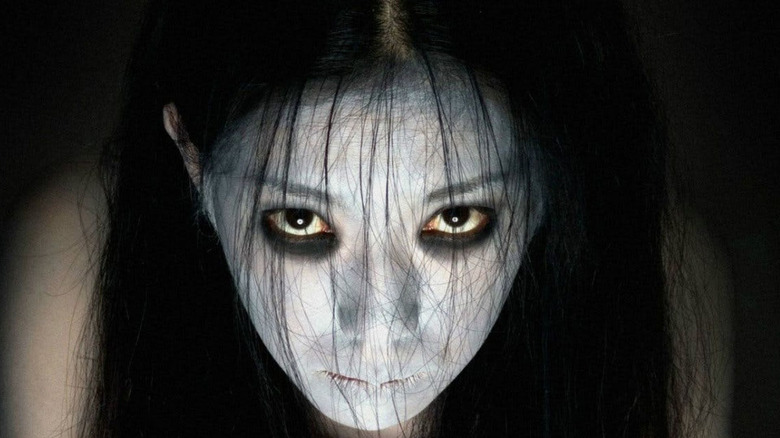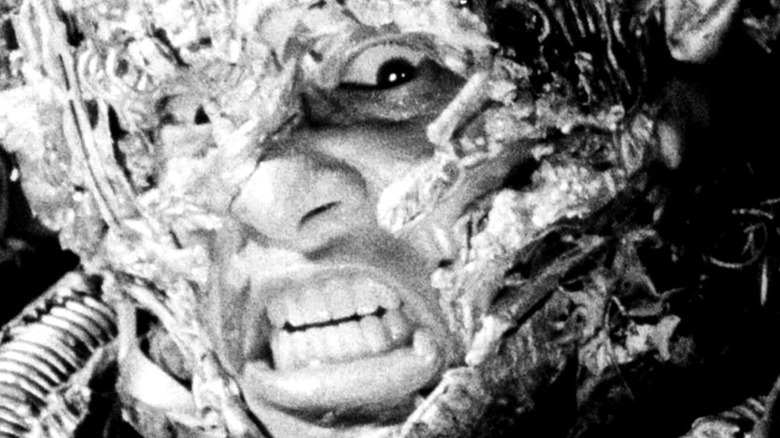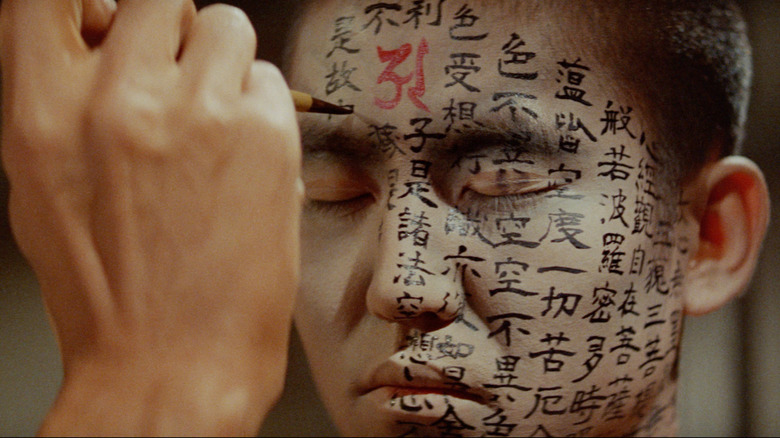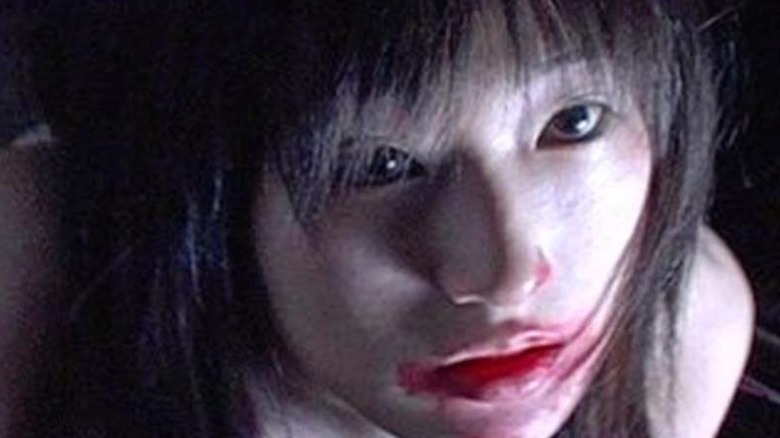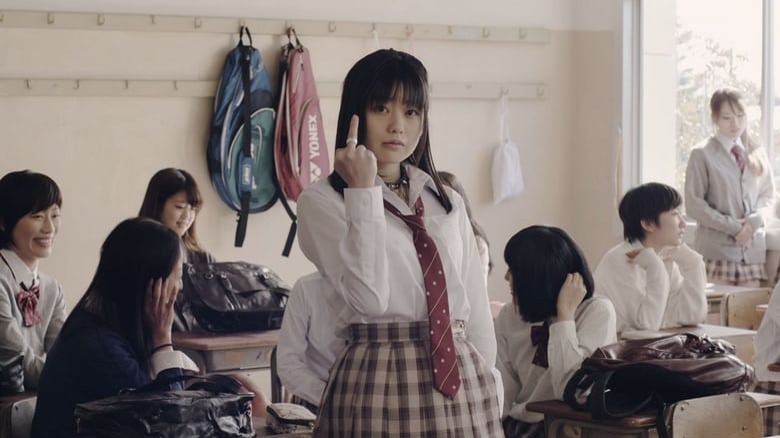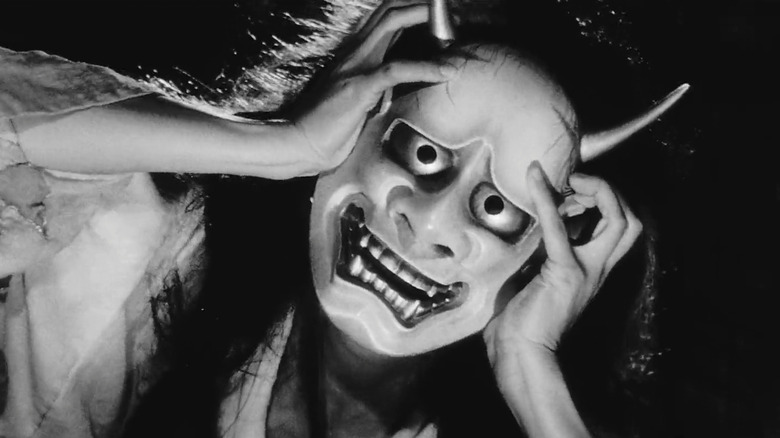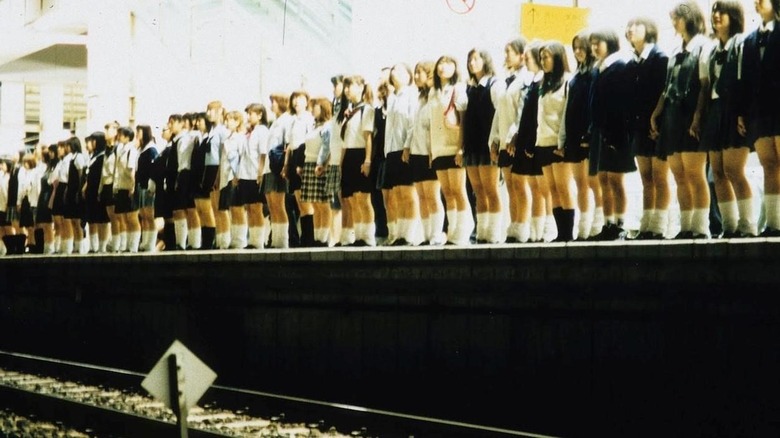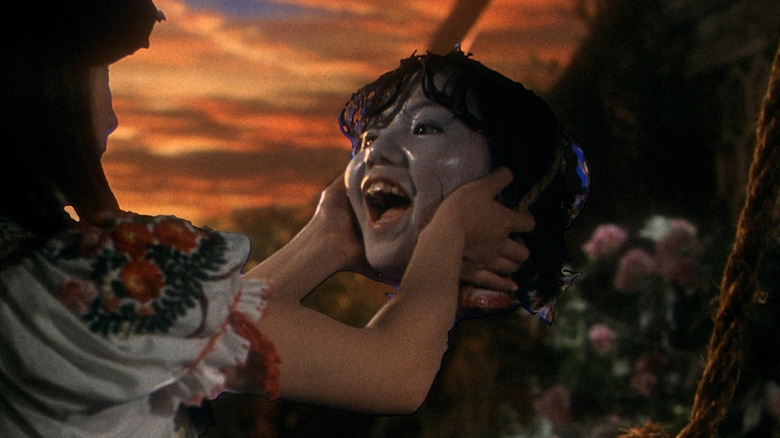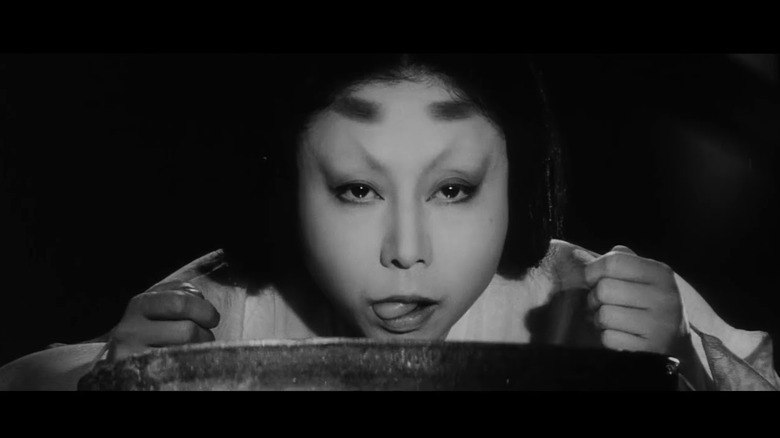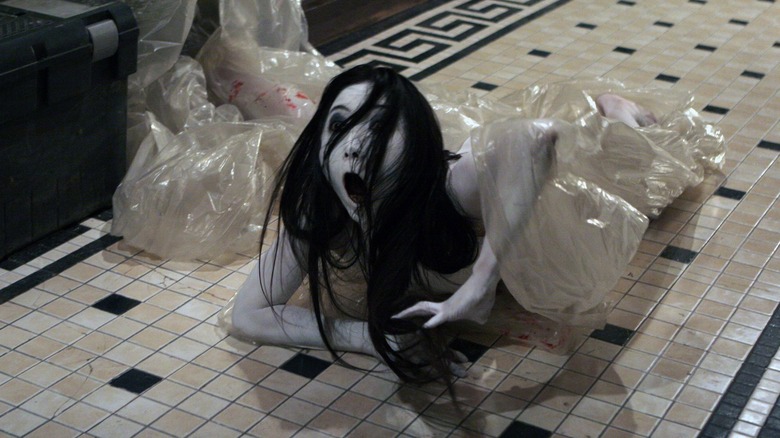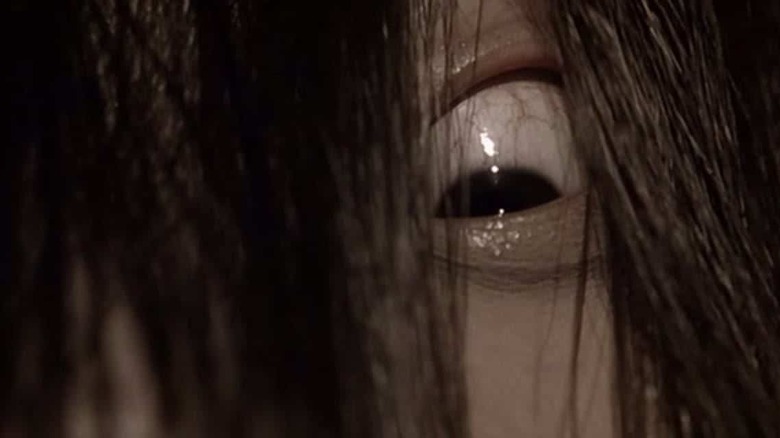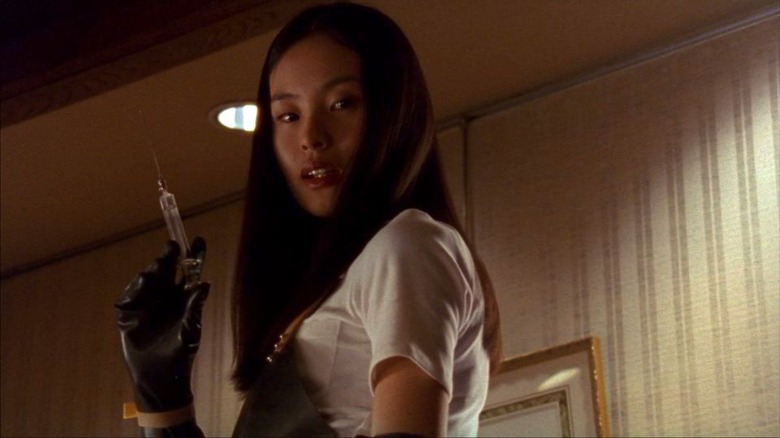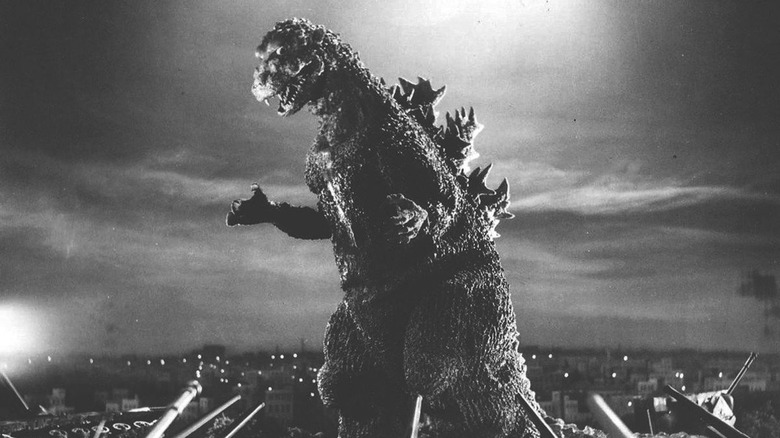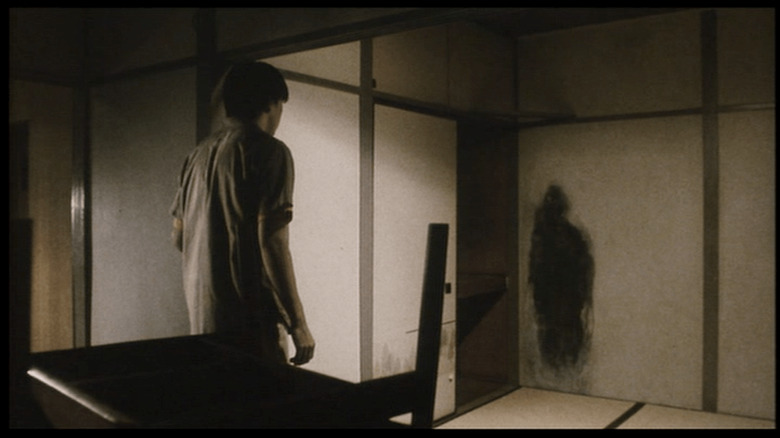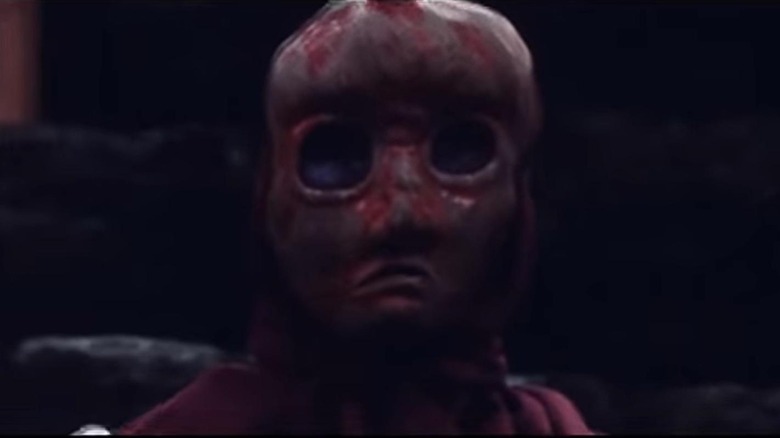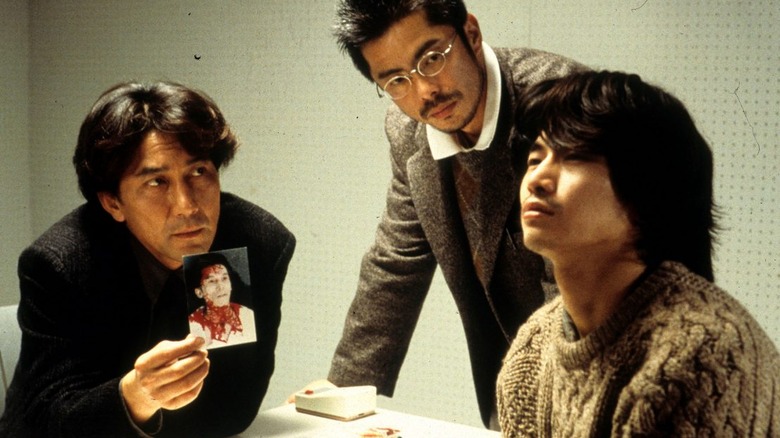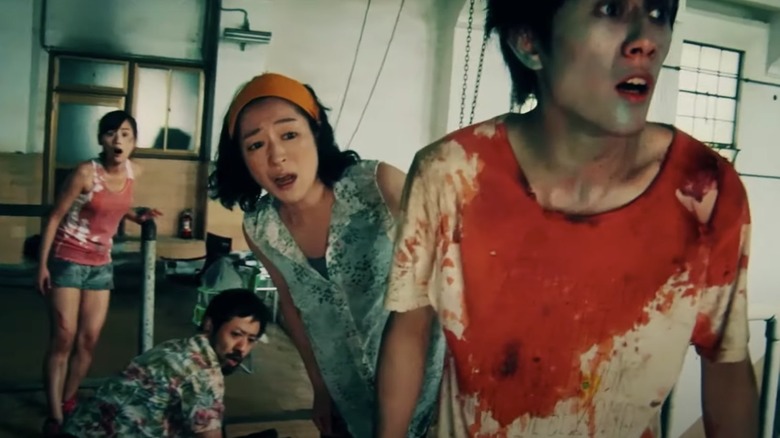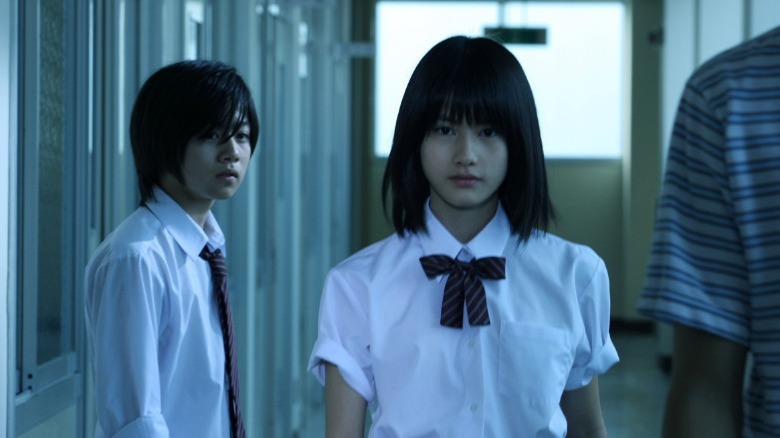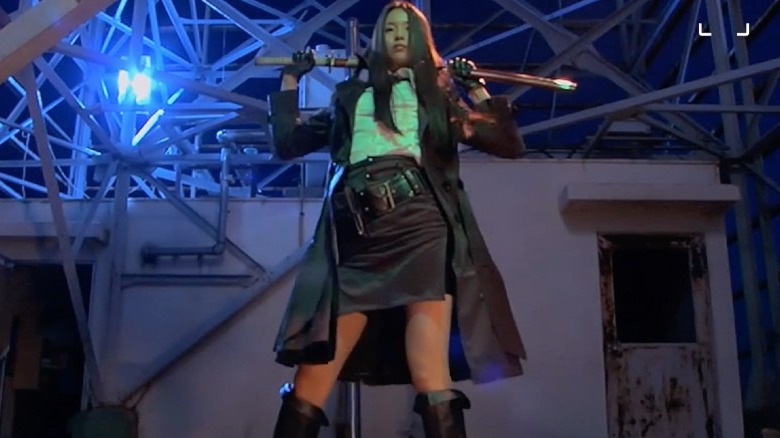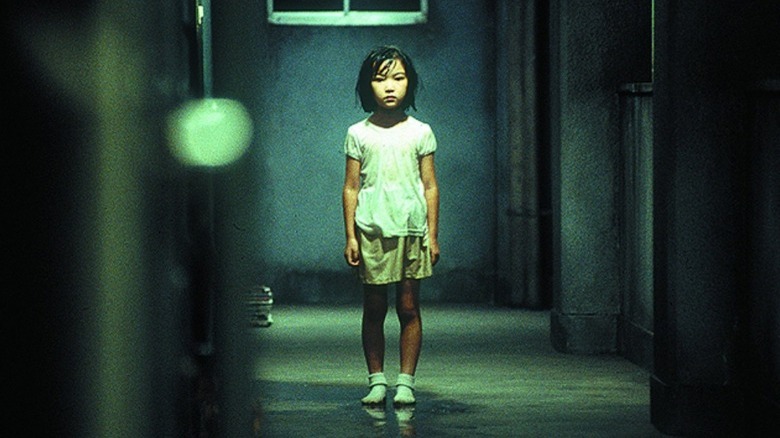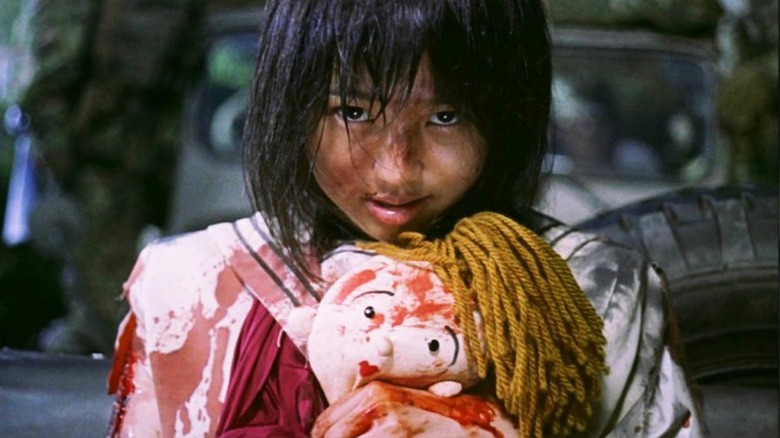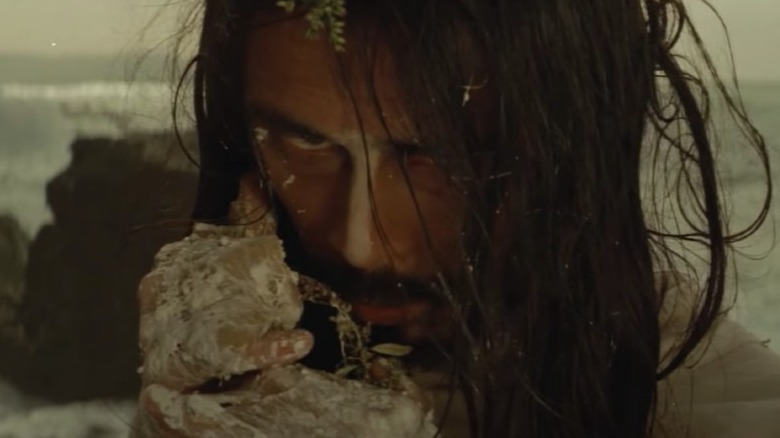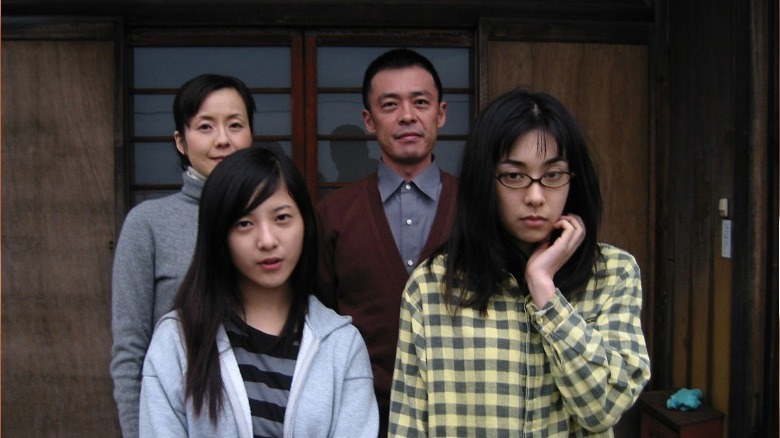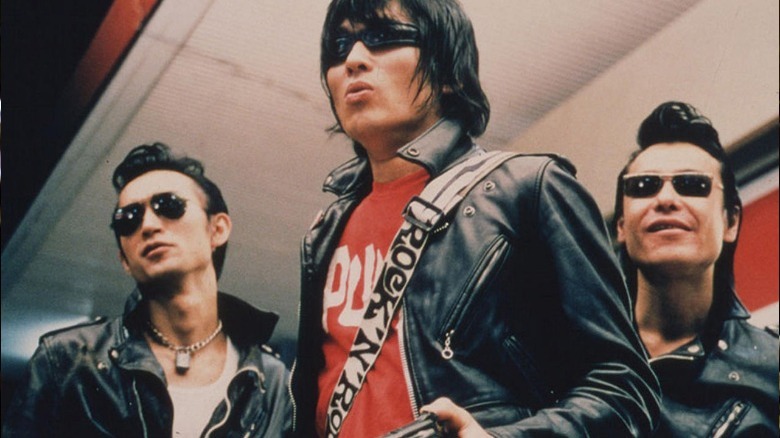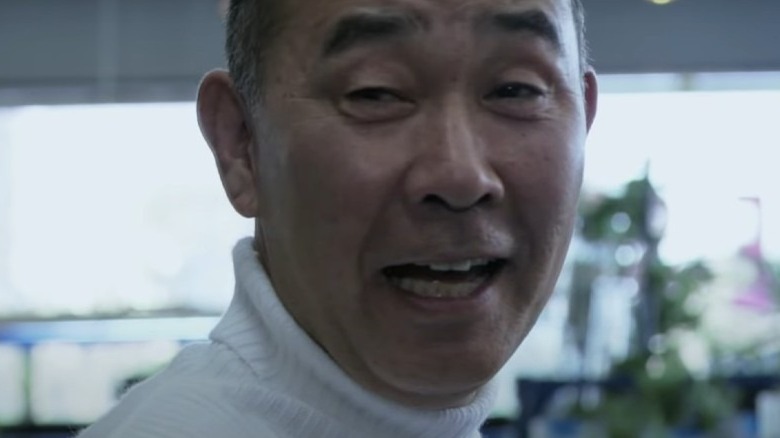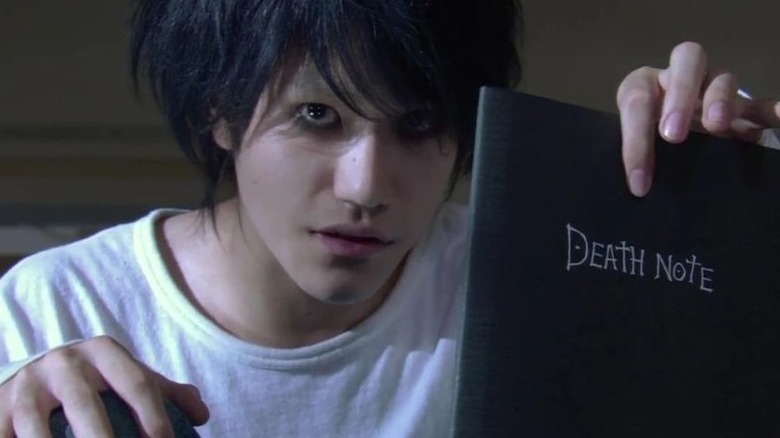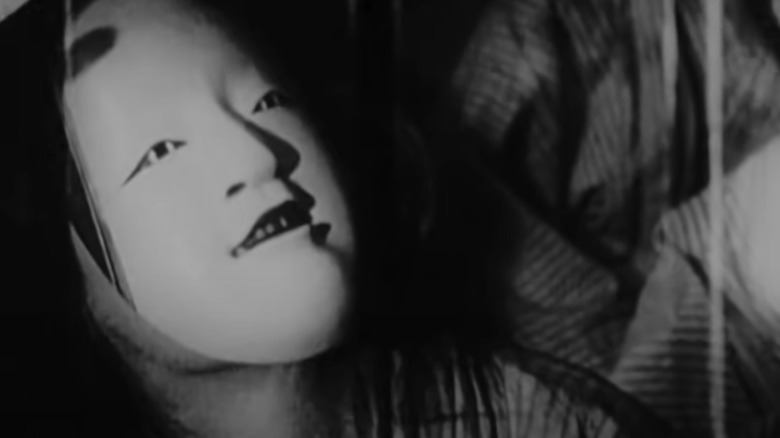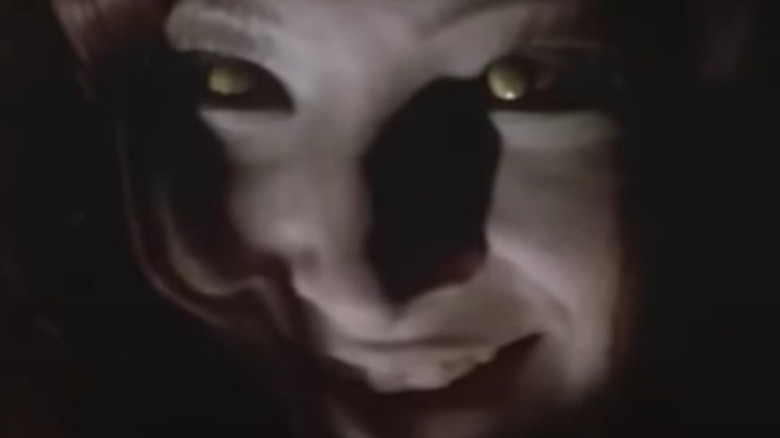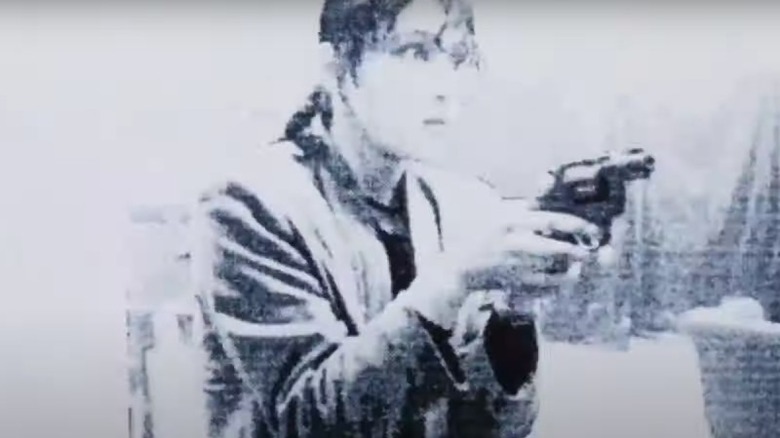The 28 Best Japanese Horror Movies Of All Time
Japanese horror (or "J-horror") films are their own kind of scary. Whether they're about serial killers or angry ghosts, these films create a different type of fear, one steeped in existential dread about what it means to exist and the loneliness that is inherent to the human condition. It's a special brand of nihilism that's often accompanied by the absurd, creating horror that points at the absurdity of life itself. This tone is what makes these films so hard to adapt to a Western perspective. They are so explicitly Japanese that removing the cultural context in turn removes the horror. It's not just horrific imagery, but in a deeper psychological fear born from increasing loneliness in the age of technology.
This list aims to capture the incredible range of Japanese horror films, from ridiculous horror comedies to harrowing tales of ghostly viruses. It also aims to capture the extensive presence of horror in Japan, which is intrinsically linked to a complex folklore tradition involving spirits, monsters, and demons. You'll see some directors get multiple shout-outs — horror greats like Takashi Miike and Sion Sono are not just masters of their craft, but they're also ridiculously prolific, and their influence on the genre cannot be limited to just one film. If you're new to Japanese horror, this is a perfect place to start your adventure into this wild and wonderful world.
Tetsuo: The Iron Man
This is a film for the gore-lovers out there. This is also a film for those who are fans of high-concept horror that is less about a set narrative and more about creating a very specific atmosphere that sets your teeth on edge. Directed by Shinya Tsukamoto, "Tetsuo: The Iron Man" chronicles the life of a salaryman (Tomorowo Taguchi) whose thoughts are plagued with images of his body penetrated by scraps of metal. These horrifying thoughts ooze into real life as the man's reality melds with that of a metal fetishist, who loves to insert metal into his skin — like, really loves it, to the point that maggots squirm in his infected flesh.
While "Tetsuo: The Iron Man" is shot in black and white, that does not make its graphic violence any less gruesome. Oozing blood resembles goopy oil as it gushes from open wounds, and human flesh becomes synonymous with machinery. But what's even more fascinating about "Tetsuo: The Iron Man" is that it is ultimately a love story between the salaryman and the metal fetishist, both of whom crave an unholy union between flesh and cold steel.
Kwaidan
"Kwaidan," which translates to "ghost story," is a 1964 horror anthology film directed by Masaki Kobayashi, based on Lafcadio Hearn's collection of Japanese folktales. The first story, "The Black Hair," follows a poor samurai who regrets leaving his loyal wife for a wealthier, yet cold, woman in order to gain better social status.
The next is "The Woman of the Snow," in which two woodcutters seek refuge in a hut during a snowstorm. There, one of them is murdered by an angry spirit, who spares the other on the condition that he never tells anyone what he's seen. His resolve is tested when he meets a beautiful woman who resembles the spirit.
The third segment is a story-within-a-story called "Hoichi the Earless," about a blind musician named Hoichi attracts the attention of a rich family that may not be human. The last tale, "In a Cup of Tea," is a short and sweet segment about a man who keeps seeing faces in his tea. "Kwaidan" is a gorgeous dive into Japanese folklore and some of their traditional ghost stories that have been told — and re-told — for centuries.
Marebito
This won't be the only found footage film on this list. After directing the cult hit (now horror classic) "Ju-On: The Grudge," director Takashi Shimizu released "Marebito," a tale about a nervous man who becomes obsessed with filming the world around him after watching a man commit suicide. Through his camera, the man hopes to better understand death.
In his quest, the protagonist travels to a bizarre world underneath Tokyo, armed with nothing but his video camera. While venturing through this strange place, he encounters a young woman chained to a wall, who he decides to "save" and bring home to his apartment. But, as he spends more time with this woman, he realizes that she won't eat, drink, or even talk — yes, we are wandering into vampire territory.
As he continues to care for the stranger, the man's life becomes more violent, and he realizes that he brought something to the surface that should have been left where it was found. "Marebito" takes a lot of cues from the works of H.P. Lovecraft, playing with the overwhelming madness intrinsic to cosmic horror.
Tag
Sion Sono is a mad genius who doesn't let the pesky things like a "cohesive narrative" hold him back. In his 2015 film "Tag," student Mitsuki (Reina Triendl) is the sole survivor of a horrific accident, during which a gust of wind cuts her bus — and her classmates — in half. That introduction sets the scene for a truly ridiculous story that involves multiple dimensions, mistaken identities, machine gun-wielding teachers, and much more.
"Tag" is a film made for gore hounds looking for something absolutely gonzo, but also shockingly feminist. As Mitsuko travels through a bloody hellscape, watching all of her friends die right in front of her, Sono questions the objectification and use of the female body in exploitation horror. So, why exactly is it called "Tag?" Is it really all just one big game? You'll just have to watch to find out.
Onibaba
Kaneto Shindo's 1964 horror classic "Onibaba" is set in 14th-century Japan, where an old woman and her daughter-in-law are trying to survive during a civil war. As they await the return of their son-slash-husband, the women murder soldiers, loot their bodies, and sell the stolen goods so they can afford to survive. But when their neighbor returns from war, things get complicated, and a strange love triangle threatens the women's violent, yet simple, way of life.
Full of tension with a dash of the supernatural, "Onibaba" is an example of Japanese horror excellence, adapting classic Japanese folklore into something that both honors the past while also bringing it into the present. Shindo's early work set a precedent for the genre, and in turn helped shape the current roster of wild and wonderful Japanese horror filmmakers.
Suicide Club
Sono makes an appearance on this list again, this time with his 2001 film "Suicide Club," which is about exactly that: a club where people commit suicide. The film opens with a large group of schoolgirls from across Tokyo, all of whom hold hands and jump together in front of a moving train. As bodies continue to pile up — literally — on the streets of Japan, Detective Kuroda (Ryō Ishibashi) tries to get to the bottom of what is causing these suicides. The answer lies in a complex series of clues that includes cryptic websites and special tattoos.
While the film grapples with serious subject matter, Sono isn't afraid to make the taboo darkly funny. This controversial film relies on a smattering of violent and absurd images, creating a cinematic experience that will keep you enthralled from beginning to end. Even with Sono's sinister playfulness, "Suicide Club" is ultimately a troubling and nihilistic film about the effects of the digital world on the younger generation, whose impressionable minds make easy targets for those with evil intentions.
Hausu
There is no way to truly capture the psychedelic essence of Nobuhiko Obayashi's wacky 1977 classic "Hausu," a film full of disembodied cats, breathtaking animation, and much, much more.
In "Hausu," a young woman named Gorgeous brings a group of her close friends to her aunt's house over the summer to relax in the countryside, but they don't know that this house is deeply haunted. Nothing but doom awaits them. "Hausu" is a film that knows exactly what it is, and Obayashi commits wholeheartedly. The result is a campy masterpiece that never pretends to be sleek; instead, "Hausu" leans into its outlandish nature, featuring poor special effects and wild animation sequences.
Of course, there's good reason for the ridiculousness: "Hausu" was written with the help of Obayashi's young daughter. It is, quite literally, from the mouth of a babe, and her honesty about what scared her as a child helps to create one of the strangest horror films to date.
Kuroneko
Shot in a beautiful monochromatic color palette, Kaneto Shindo's 1968 ghost story "Kuroneko" is a devastatingly gorgeous revenge tale about a woman and her daughter-in-law, who return as angry spirits after being raped and murdered by violent samurai during a war in feudal Japan. If that sounds similar, it's because Shindo wrote and directed "Onibaba" just four years earlier.
These two spirits, known as onryo, haunt a popular road, seducing lonely samurai and luring them away to murder them. They take the form of black cats as they pounce and yowl at their prey. Their feline forms also lend to some impressive aerial stunts from the two lead female performers. "Kuroneko" is a fascinating take on the rape-revenge tale; even in death, these two women must try to find justice for the harm inflicted upon them by those in power. While there is a lot of murder in the film, it contains almost no gore, instead relying on an oppressive and ominous atmosphere to create its unsettling tone.
Ju-On: The Grudge
Released in 2002, Takashi Shimizu's "Ju-on: The Grudge" was the third film in a franchise, but the first to be released in theatres, and therefore the first of the films to really make a large mark on the horror genre. When a woman named Kayako and her son are murdered by her husband after he discovers her infidelity, they die with a grudge in their hearts. Their rage and anger spreads like an infection, and the two slowly torture and kill anyone who moves into their home.
The tradition of rage-filled ghosts who refuse to pass on peacefully is a traditional Japanese horror trope, particularly scorned women who seek revenge on the men who wronged them. "Ju-On: The Grudge" introduced many iconic horror images, as well as the unforgettable bone-chilling screech that emanates from a young boy's mouth as he descends on his next victim.
Shimizu later adapted "Ju-On: The Grudge" into an English-language film featuring a primarily white cast, but the original is a quintessential Japanese horror films that will haunt your dreams. It's impossible to forget the boy's death rattle, or the sound of Kayako creepily walking down the stairs as her joints creak and snap.
Ringu
"Ringu" is a classic Japanese horror film, and the one that made J-horror a mainstream concern internationally. Released in 1998 and directed by Hideo Nakata, "Ringu" is about a cursed videotape that kills whoever watches it after seven days. The contents of the tape are an amalgamation of unsettling images, culminating in a sequence in which a young girl climbs out of a well.
While investigating the tape, reporter Reiko Asakawa travels to the small island of Izu, looking to discover the tape's origin and the identity of the girl in the well; is it real, or is it an elaborate prank? During her investigation, those around Asakawa die violent deaths after watching the tape themselves. "Ringu" is the first film featuring the vengeful spirit Sadako, who has that long, wet, black hair draped over her face. This was also one of the first films to tackle Japan's growing digital landscape, and the horrors that lie in our increasing dependence on technology.
Audition
Takashi Miike paints with a bloody, gruesome brush, creating some of Japan's most extreme horror films, including "Visitor Q" and "Ichi the Killer." But perhaps his best work is his 1999 film "Audition," one of James Gunn's favorite horror movies, not to mention a distressing story about finding romance and the harmful misogyny of Japan's older generation.
Shigeharu Aoyama (Ryo Ishibashi) is a lonely film producer and widower who lives a quiet life. One day, his adult son suggests that Aoyama marry again. So, to help Aoyama find love, his friend Yasuhisa Yoshikawa holds auditions for a fake film role; in reality, the "part" is Aoyama's future wife.
During the process, Aoyama becomes enamored with the quiet and mysterious Asami (Eihi Shiina). As their relationship blossoms, he begins to discover dark secrets about her past — dismembering abusers, copious amounts of piano wire, and bowls of vomit. While "Audition" starts as a slow-paced relationship drama, the film's final act is well worth the build-up — it's one of the most shocking sequences ever committed to film. "Audition" also serves as the perfect introduction to Miike's work, illustrating his unique style of filmmaking as well as his uncanny ability to create disgusting and disquieting images.
Godzilla
Kaiju movies are often thought of as campy spectacles with no actual fear factor. Cheap rubber costumes distract from the citywide destruction. Massive monster battles are the centerpieces, not the trauma inflicted upon millions of people. But the original kaiju movie, "Godzilla," which was directed by Ishiro Honda in 1954, is a terrifying monster movie that examines the horrors of nuclear war.
In his original iteration, Godzilla is an ancient creature awakened from his underwater slumber by atomic bomb testing in the Pacific Ocean. He now travels across Japan, leaving devastation in his wake. Not only is the city of Tokyo shown burned to the ground, but Honda also focuses on the individuals affected by Godzilla's destruction, depicting hospitals packed full of sobbing families and dying children. In this film, Godzilla is not the internet's thick-thighed boyfriend; he's a terrifying creature sent to wreak havoc on those who try to play God.
Pulse
At the turn of the century, one of Japan's biggest fears was the increasing isolation that came with the growth of the internet. Kiyoshi Kurosawa encapsulates that cultural anxiety in his 2001 film "Pulse," which is about a ghostly virus that leaks from the internet into reality. In parallel story lines, two young women discover that something strange is happening to their friends, who begin committing suicide after leaving cryptic notes asking for help.
As their stories converge, the women discover that the spirit world has found a way to access and infect the real world through internet connections. It's like a computer virus, but one that also takes over the minds of real people. And, like any virus, the mysterious force begins to proliferate exponentially, claiming more and more lives every day. Kurosawa creates some very harrowing moments, including a scene with a slow-dancing ghost who is more menacing than any other cinematic spirit of recent memory.
Noroi: The Curse
The found footage genre is horrifying, given its ability to place audiences in the shoes of terrorized characters by using a first-person point of view. But director Kōji Shiraishi takes it to another level with his 2005 film, "Noroi: The Curse." The film is presented as an incomplete documentary by paranormal researcher and journalist Masafumi Kobayashi (Jin Muraki), who is known for his books, documentaries, and TV series about ghostly events around Japan. In this documentary, Kobayashi begins investigating reports of disembodied sounds of babies crying, but the film quickly becomes about something much more sinister.
While "Noroi: The Curse" states from the very beginning that Kobayashi's house has burned down and that he's missing, this does not make any of Kobayashi's revelations any less terrifying, particularly in regard to some deeply unsettling imagery at the film's end. This is not the typical found footage film, full of shaky footage and haunted forests. This is a sleek pseudo-documentary that plays with the truth and how filmmakers build trust with the audience. "Noroi: The Curse" is not only a shining example of Japanese horror, but of the found footage genre as a whole.
Cure
Kiyoshi Kurosawa is a master of psychological horror, creating stories that burrow under your skin and fester, haunting you for days. His 1997 film "Cure" — one of "Parasite" director Bong-Joon Hoo's favorite movies — is a prime example, capturing a deep-seated fear of losing control and the destruction that often comes with obsession. Kenichi Takabe (Kōji Yakusho) is a detective investigating a string of strange murders in which all of the victims are marked with a giant X, and yet were all killed by different people. Even weirder, the murderers have no memory of committing the crimes, and have no real motivation for the killings.
Takabe struggles to understand the mystery, until he captures Mamiya (Masato Hagiwara), who seems to have short-term memory loss. However, the detective slowly learns that Mamiya is a master of hypnotism, and that he is using those gifts to manipulate innocent people. "Cure" devolves into a tense game of cat and mouse, set against a drab, gray background that creates an oppressive atmosphere and smothers both the audience and the characters alike. "Cure" is a perfect example of Japanese horror, and how it easily and unsettlingly combines of disturbing imagery and existential dread.
One Cut of the Dead
Shinichirou Ueda's "One Cut of the Dead" is one of the most unexpected genre treats ever made. Billed as a zombie comedy, it fully embraces every cliche and trope in the book, but completely flips the format on its head. The movie follows a film crew that's shooting its very own apocalyptic thriller in an abandoned water plant when real zombies attack 一 or so the viewer thinks. The second half of the film explores exactly what is going on, revealing various behind-the-scenes antics and how the film is being shot in only one take.
"One Cut of the Dead" manages to totally reinvent a stale genre. One could argue that it's a full-on comedy that uses horror conventions, but the gore and violence is truly to die for. Moldmaker Kazuhide Shimohata and assistant Kasumi Nakamura craft wonderfully bloody sequences that may haunt you, with a big assist from Yusuke Kambayashi's excellent visual effects. Go in expecting the unexpected, and you'll still be surprised.
Confessions
It's not easy to open a film, much less a horror film, with a 20-minute monologue. And yet, Tetsuya Nakashima's "Confessions," based on author Kanae Minato's 2008 novel, begins with a brilliant and emotionally-grueling performance by Takako Matsu, who plays a high school teacher named Yuko Moriguchi. Her epic speech details her plans to resign from her position, and lays out exactly why: the death of her daughter at the hands of two classmates. Flashbacks twist like barbed wire around the present, slowly puncturing the story until it draws copious amounts of blood.
You want to go into "Confessions" mostly blind. It's a film brimming with twists and turns, and brings up countless moral questions. They say revenge is a dish best served cold, but Yuko exacts hers piping hot. The early exposition dump front loads the film, and there's a reason for it: The story soon devolves into a lesson about vengeance, harboring resentment, and the lines you draw in the sand. It also explores the birth of a true psychopath, one whose malevolence is born out of a deep desire to be seen and heard.
Tokyo Gore Police
Truth be told, there's no way you could ever be ready for "Tokyo Gore Police," a 2008 horror-action film. Directed by Yoshihiro Nishimura, who co-wrote the script with Kengo Kaji and Sayako Nakoshi, the film is a relentless acid trip into bonkers-ville. In the first two minutes, an exploding head sets the pace for what is ultimately a nauseating and mind-altering display of gore and violence. It is without a doubt one of the grossest films released in the last 30 years.
Eihi Shiina stars as Ruka, a vengeful police officer tasked with hunting down "engineers," or monstrous human beings with machine mutations. Limbs and heads are frequently amputated or decapitated, resulting in a flood of blood and meaty chunks, and you rarely get a moment's peace before the next sickening, over-the-top sequence slams into your eyeballs. In her quest to avenge her father's murder, Ruka combats a number of engineers. Her journey only leads to more wildness; in this film, every frame is as shocking as the last. While watching, you may want to have a trash can handy.
Dark Water
There's a reason why "Dark Water" feels as though it resides in the same universe as "Ringu" and its sequels. Author Koji Suzuki is the genius storyteller behind both works. With director Hideo Nakata at the helm, the film (adapted from Suzuki's work by Yoshihiro Nakamura and Kenichi Suzuki) follows a divorced woman and her young daughter, who move into a derelict apartment building. Amidst a bitter custody battle, Yoshimi Matsubara (Hitomi Kuroki) is doing everything she can to give Ikuko (Rio Kanno) the best life possible.
Within the first few days, a leaky ceiling becomes a big problem. Yoshimi complains to the front desk, but to no avail. She puts a pot on the floor to catch the run-off and goes about her life. She has just started a new job, and it's going fairly well for her. Soon, however, a dark mystery unfolds involving a local missing girl, a bright red satchel, and rising flood waters. "Dark Water" does not necessarily reinvent the wheel by any means, but it's final act is packed with mood and ghoulish frights.
Battle Royale
The 2000 action-thriller redefined an entire subgenre of horror. Directed by Kinji Fukasaku, "Battle Royale" (based on a 1999 novel by Koushun Takami) addresses violent acts from the new generation and their growing hatred for adults, while commenting upon the treatment of millennials and how they were, allegedly, the cause of society's downfall. The film was so controversial that it didn't see a United States release until 2012.
In the world of the movie, the government passes the "BR ACT," which forces middle school students to battle to the death, in order to curb rising crime rates,. While on a field trip, a fresh crop of middle schoolers are subdued by a sleeper agent, gagged, and carted off to a secluded island. When they awake, they discover they've been bound in metal dog collars and forced to enroll in the deadly tournament. Given a survival bag that contains food, water, and a random weapon, they must survive for three days. But here's the catch: only one student will walk away alive.
"Battle Royale" is unafraid to take big risks and kill off core characters, so getting attached to anyone is a huge mistake. More than two decades later, it's easy to see why it became such a groundbreaking film. From "The Hunger Games" to Netflix's mega-hit series "Squid Game," it's influence is unmistakable.
Horrors of Malformed Men
The 1969 film "Horrors of Malformed Men," directed by Teruo Ishii, pulls elements from two Edogawa Rampo novels: "Strange Tale of Panorama Island" and "The Demon of the Lonely Isle." It's twisty and turny, resulting in a frothy blender of film noir, body horror, and the truly demented.
Upon escaping a mental asylum, would-be doctor Hirosuke (Teruo Yoshida) goes in search of the truth about his past and why he was admitted into a psychiatric facility. His journey is a wild one. During his quest, he befriends a circus girl and receives a tip about an abandoned island, a rich family called Komoda, and deeply buried secrets. Once he arrives on the island, he meets a deranged scientist who is hellbent on creating what he calls an "ideal world" by surgically altering human beings. Some are tethered to another person; others are stitched to any manner of furry beasts. The macabre menagerie is among the most unsettling and weird images ever put on screen. When all is revealed in the finale, well, you may not even believe it yourself.
Noriko's Dinner Table
"Noriko's Dinner Table" is an epic, 159-minute poetic tragedy. The film, written and directed by Sion Sono, follows 2002's "Suicide Club" and delves further into the psychology of human desire, desperation, and delusion. Noriko (Kazue Fukiishi) longs to feel needed and included in the world, often wandering aimlessly through her life. Her stern father wants her to go to a local community college, but she has set her sights on Tokyo, where, her father claims, the boys are no good.
During a late-night power outage, Noriko packs up her most precious belongings and heads into the big city. There, she befriends online companion Ueno54 (Tsugumi), who introduces Noriko to I.C. Corp, a company that rents out people who pretend to be members of their customers' families. In living fake lives at the behest of various clients, Noriko discovers what it means to be desired.
"Noriko's Dinner Table" is as much about the dark underbelly of the city as it is about Noriko's self-actualization and her growing understanding of her identity. While the mystery unravels ever-so slowly, you'll stick around for Fukiishi's hypnotic lead performance.
Wild Zero
As far as horror-comedy goes, "Wild Zero" is top-tier, head-bangin', post-apocalyptic madness. Directed by Tetsuro Takeuchi, this 1999 feature film follows a Guitar Wolf-obsessed fan named Ace (Masashi Endō) and his new love interest, Tobio (Kwancharu Shitichai), as they navigate the end of the world. A meteorite crashes on the outskirts of a town called Asahi, a swarm of flesh eaters emerge from the wreckage, and all hell literally breaks loose.
From the zombies' glacial pace and exaggerated makeup to a gleeful rock soundtrack, "Wild Zero" is ripe for a midnight crowd. "Rock and roll never dies!" seems to be the central thesis, wrapped tightly around various love stories and fervent machismo. The real-life garage-rock band Guitar Wolf plays an important role in saving humanity, and that's just scraping the surface. The gore is chunky, the characters make outrageous decisions, and elements of slapstick comedy are guaranteed to elicit chuckles every few minutes. If nothing else, "Wild Zero" is a good distraction from a chaos-fueled world.
Cold Fish
In the 2010 film "Cold Fish," director Sion Sono, who co-wrote the script with Yoshiki Takahashi, loosely excavates the real-life horrors of two serial killers, Sekine Gen and Hiroko Kazama. What begins as an intimate, low-scale drama swiftly devolves into a horrific, grimy, and hard-to-stomach display of humanity's depravity. Shamoto (Mitsuru Fukikoshi) is terribly unhappy in his marriage to his second wife Taeko (Megumi Kagurazaka), so he finds great delight when fish store owner Murata (Denden) expresses an affection for him.
Now romantically ensnared, Murata enlists Shamoto as an accomplice in a frenzy of small-scale murders. Soon, their relationship becomes twisted beyond belief. "Cold Fish" is littered with gore that'll make even the least squeamish among us a bit nauseous. It's a true making-a-murder template that guides the viewer into a merciless and seemingly endless maze of graphic violence so uncomfortable that you won't soon forget it.
Death Note
Based on a popular manga series, 2006's "Death Note" follows a college student named Light Yagami (Tatsuya Fujiwara) and his mission to create an ideal society by eradicating criminals. His journey begins when he discovers a mysterious notebook titled "Death Note." When Light scrawls various individual's names in its pages, they die. So, he begins to fill the journal with those he considers evil, hoping to make the world a better place. The rash of resulting murders tips off Interpol, and detective L (Kenichi Matsuyama) is tasked with finding out the truth and tracking Light down as the young man spirals out of control.
Directed by Shusuke Kaneko, "Death Note" fully embraces its zany premise, particularly with the inclusion of a CGI ghoul rocking cool emo fashions (yes, really). It's the actors' commitment and the production team's fantastic work that marks this film as a freaky, weird, and perhaps silly must-watch.
A Page of Madness
"A Page of Madness" more than lives up to its title. This silent film had been lost to time until director Teinosuke Kinugasa discovered a copy in his storage shed in 1971. Nearly 100 years later, its surrealist expressionism remains something of a marvel, a creative choice that goes against most other mainstream fare of the era.
Its story revolves around a janitor (Masao Inoue) who takes up a position at an asylum in the countryside. His wife (Yoshie Nakagawa) has been committed after suffering abuse at the hands of her husband, and then a mental breakdown. The janitor's daughter (Ayako Iijima) also becomes a patient in the mental hospital, adding a strained familial through line to the film. When his wife suffers a blow, the janitor intervenes and scuffles with several other inmates. This moment sends him spiraling out of control and wandering through a sequence of disturbing fantasies.
The janitor loses all sense of self and tumbles through distorted visions of the past, present, and what could be the future, but there's no telling what is actually real and what are figments of the man's imagination. His guilt is overwhelming. "A Page of Madness" makes for a great triple bill with 1920's "The Cabinet of Dr. Caligari" and 1955's "Dementia," two similarly expressive character studies about mental health and tragedy.
If you or someone you know is dealing with domestic abuse, you can call the National Domestic Violence Hotline at 1−800−799−7233. You can also find more information, resources, and support at their website.
The Vampire Doll
Michio Yamamoto's "The Vampire Doll" is a quiet chiller. Only 71 minutes long, the 1970 vampire tale emits a shocking coldness that'll make you shiver down to the bone. When a young gentleman named Kazuhiko Sagawa (Atsuo Nakamura) pays a visit to his fiancé, Yuko Nonomura (Yukiko Kobayashi), in the country, Yuko's mother reveals the woman suffered a tragic fate. Before long, Kazuhiko meets a grisly destiny of his own.
After Kazuhiko disappears without a trace, his sister, Keiko Sagawa (Kayo Matsuo), begins looking into his whereabouts. She takes a trip to the same secluded estate, with her soon-to-be-husband Hiroshi Takagi (Akira Nakao) in tow. Keiko immediately suspects that Yuko's mother has ill intentions, and that she may know what happened to her brother. After poking around the property, Hiroshi pretends that his car has broken down, a decision that allows the couple to stay a little bit longer in order to get to the truth.
"The Vampire Doll" serves up some haunted house tricks as part of a blood-sucking banquet. The vampire peeks out of the shadows with glowing amber eyes; their thirst is unquenchable, and yet the actual blood is kept to a minimum on screen. It's not needed. The film has plenty of other frightful images that'll turn your stomach. Oh, and watch out for that third act, too — the whiplash may break your neck.
Evil Dead Trap
Toshiharu Ikeda's "Evil Dead Trap," written by Takashi Ishii, is as underrated as they come. What begins as a typical slasher film takes a hard left turn into bonkersville in the final 20 minutes. Truly, you won't see it coming.
Miyuki Ono stars as late-night TV emcee Nami Tsuchiya, who receives a mysterious package containing a snuff film and decides to investigate. Nami and a team of reporters come up with a plan to figure out where it was created by following the road signs and landmarks on the tape. It leads them to an abandoned military base where, against her better judgment, Nami trespasses through the overgrown brush and the rusted chain link fence. She'll do anything to get the story of her career.
For slasher fiends, "Evil Dead Trap" has all kinds of killings: impalements, strangulations, and decapitations. However, it's also notable for Ikeda's experimental camera work, which includes a scrambling, overexposed first-person point of view and a hypnotically-cool sequence in which a camera flash is used to light the scene. As the killer closes ranks, the death scenes grow increasingly more violent and nauseating, particularly during an excruciatingly brutal sexual assault. "Evil Dead Trap" is full of sky-high ambition, and it sticks the landing with acrobatic agility.
If you or anyone you know has been a victim of sexual assault, help is available. Visit the Rape, Abuse & Incest National Network website or contact RAINN's National Helpline at 1-800-656-HOPE (4673).
